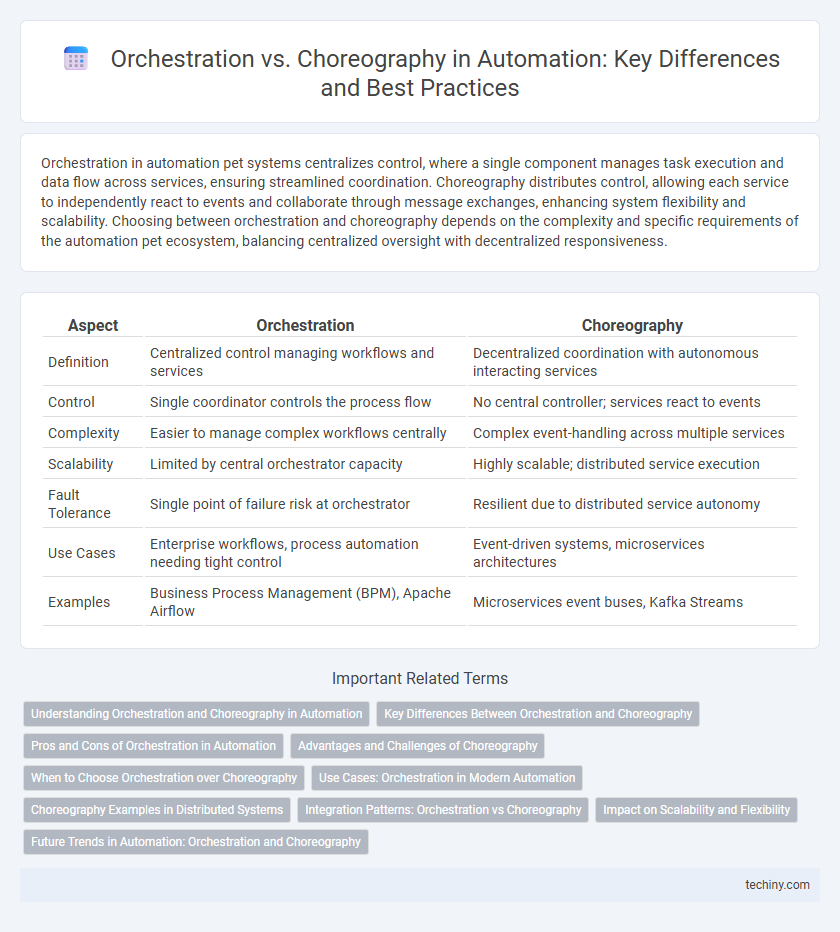Orchestration in automation pet systems centralizes control, where a single component manages task execution and data flow across services, ensuring streamlined coordination. Choreography distributes control, allowing each service to independently react to events and collaborate through message exchanges, enhancing system flexibility and scalability. Choosing between orchestration and choreography depends on the complexity and specific requirements of the automation pet ecosystem, balancing centralized oversight with decentralized responsiveness.
Table of Comparison
| Aspect | Orchestration | Choreography |
|---|---|---|
| Definition | Centralized control managing workflows and services | Decentralized coordination with autonomous interacting services |
| Control | Single coordinator controls the process flow | No central controller; services react to events |
| Complexity | Easier to manage complex workflows centrally | Complex event-handling across multiple services |
| Scalability | Limited by central orchestrator capacity | Highly scalable; distributed service execution |
| Fault Tolerance | Single point of failure risk at orchestrator | Resilient due to distributed service autonomy |
| Use Cases | Enterprise workflows, process automation needing tight control | Event-driven systems, microservices architectures |
| Examples | Business Process Management (BPM), Apache Airflow | Microservices event buses, Kafka Streams |
Understanding Orchestration and Choreography in Automation
Orchestration in automation involves a centralized controller managing tasks and workflows to ensure seamless integration and execution across multiple systems. Choreography distributes control, where each system independently executes its part and communicates with others through predefined events. Understanding these approaches helps organizations optimize automation strategies by balancing control, flexibility, and scalability.
Key Differences Between Orchestration and Choreography
Orchestration centralizes control by managing and directing all automated tasks within a workflow from a single point, ensuring seamless process execution and monitoring. Choreography, in contrast, relies on decentralized interactions where individual services communicate and coordinate independently based on event-driven messages, promoting flexibility and scalability. Key differences include the control structure--centralized for orchestration and distributed for choreography--as well as their approach to service communication and process management.
Pros and Cons of Orchestration in Automation
Orchestration in automation centralizes control by managing and coordinating multiple services or processes from a single point, enhancing visibility and simplifying error handling. It offers efficient resource allocation and streamlined workflow management but can lead to a single point of failure and potential scalability challenges in complex systems. Relying on a centralized controller may introduce latency and reduce flexibility compared to decentralized approaches like choreography.
Advantages and Challenges of Choreography
Choreography in automation offers enhanced scalability and flexibility by enabling decentralized process control, allowing multiple services to interact independently without a central orchestrator. Challenges include increased complexity in monitoring and debugging due to lack of a single control point, making error handling and process visualization more difficult. Despite these hurdles, choreography facilitates dynamic, real-time service collaboration, which is ideal for microservices architectures and event-driven systems.
When to Choose Orchestration over Choreography
Choose orchestration over choreography when centralized control and visibility are essential for managing complex workflows across multiple systems. Orchestration provides a single point of command, simplifying error handling, monitoring, and compliance in enterprise automation. This approach suits scenarios requiring strict coordination, audit trails, and detailed process governance.
Use Cases: Orchestration in Modern Automation
Orchestration in modern automation centralizes control by managing and coordinating multiple automated tasks and workflows through a single orchestrator, streamlining complex processes like IT infrastructure management and cloud service provisioning. Use cases include end-to-end service delivery automation, where it ensures seamless integration between disparate systems such as virtual machines, containers, and network resources. This approach enhances efficiency, reduces human errors, and accelerates time-to-market in enterprise environments requiring precise control and governance.
Choreography Examples in Distributed Systems
Choreography in distributed systems enables independent services to interact through event-driven communication without a central coordinator, enhancing scalability and fault tolerance. Examples include microservices architectures where services respond to events via message brokers like Apache Kafka or RabbitMQ, allowing asynchronous workflows and real-time data processing. Event sourcing and CQRS patterns often implement choreography to maintain data consistency across distributed components efficiently.
Integration Patterns: Orchestration vs Choreography
Orchestration centralizes control by managing interactions and workflow within a single service, streamlining integration through a unified process engine. Choreography distributes responsibility across multiple independent services, each producing and consuming events to achieve integration via decentralized, event-driven patterns. Choosing between these integration patterns depends on system complexity, scalability needs, and the desired level of service autonomy.
Impact on Scalability and Flexibility
Orchestration centralizes control, enabling streamlined scalability by managing workflows through a single control point, which simplifies monitoring but may introduce bottlenecks. Choreography distributes control across independent services, enhancing flexibility and allowing systems to scale dynamically without waiting for a central coordinator, though it requires robust service communication protocols. The choice between orchestration and choreography significantly influences how adaptable and scalable an automation framework can be in complex, evolving environments.
Future Trends in Automation: Orchestration and Choreography
Future trends in automation emphasize the integration of orchestration and choreography to enhance system efficiency and scalability. Advanced orchestration tools will enable centralized control while leveraging AI-driven choreography for decentralized, real-time decision-making. This hybrid approach optimizes workflow automation, supports complex multi-service interactions, and accelerates digital transformation across industries.
Orchestration vs Choreography Infographic

 techiny.com
techiny.com